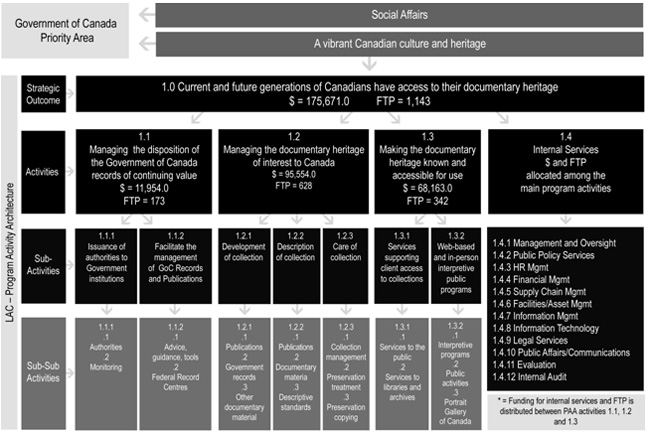Common menu bar links
Breadcrumb Trail
ARCHIVED - Library and Archives Canada
 This page has been archived.
This page has been archived.
Archived Content
Information identified as archived on the Web is for reference, research or recordkeeping purposes. It has not been altered or updated after the date of archiving. Web pages that are archived on the Web are not subject to the Government of Canada Web Standards. As per the Communications Policy of the Government of Canada, you can request alternate formats on the "Contact Us" page.
Section I - Overview

Thanks to the contributions of dynamic communities across the country and tremendous creative talent, Canadians have a wonderfully rich and diverse cultural heritage. Canada's unique brand of culture has overcome the challenges posed by our vast geography and has played a critical role in strengthening the Canadian federation. Our creative and innovative society embraces the tremendous possibilities offered by rapidly changing technologies. The Canadian Heritage portfolio organizations work to ensure that the cultural sector is able to take advantage of every opportunity available and that Canadian arts and culture continue to be robust and accessible to people here at home and around the world.
The strategic direction that Library and Archives Canada (LAC) is taking clearly demonstrates this. LAC is using vehicles such as the Internet and television to bring Canada's documentary heritage directly to Canadians, no matter where they live. By digitizing a range of materials from a priceless national collection in all media, LAC is placing items that were once only accessible to some, just a mouse click away for everyone.
Canada's documentary heritage extends to the important government records of the past that describe decisions that continue to shape Canadian life today. LAC is playing a critical role in supporting our Government's commitment to accountability by leading the modernization of government record-keeping policies, practices, and procedures. This is only one part of an ambitious LAC agenda that will gain greater worldwide exposure during the conference of the International Federation of Library Associations and Institutions taking place in Québec City at the height of its 400th anniversary celebrations. There, some 5,000 participants will see Canada's commitment to managing its documentary heritage and making it known through the work of one of the world's most innovative cultural institutions, Library and Archives Canada.
As the work plan outlined in this 2008-09 Report on Plans and Priorities illustrates, Library and Archives Canada will continue to preserve and promote our cultural heritage, which is at the very heart of what it means to be Canadian.
The Honourable Josée Verner, P.C., M.P.
Message from the Librarian and Archivist of Canada
Canada has built a broad, deep, diverse documentary heritage collection. It represents a rich resource that enables Canadians to understand our past and present-and offers a profound legacy for future generations. As its steward and guardian, Library and Archives Canada is constantly building the collection, caring for it and making it known to Canadians and people around the world who are interested in the stories of Canada.
Our work takes place in constantly evolving circumstances. Challenges arise and opportunities present themselves. We have accomplished a great deal in recent years in terms of building a collection with items from Canada's past and the digital information being generated now. We have made our collection more accessible than ever to Canadians no matter where they live. We have led a process to modernize government recordkeeping in order to support improved accountability and more efficient, effective public administration.
Our 2007-2010 business plan is focusing LAC management attention and resources on priorities in becoming the kind of knowledge institution that Canada needs. Under that plan, we are taking full advantage of the new digital information environment. Initiatives such as the Canadian Digital Information Strategy and the Canada Project that are under development now are partnerships putting Canada on track to capture much more of the digital information being produced today, while also supporting the digitization of older material in formats such as print, film, video and audio.
We are continuing to reinforce our leadership role in improving recordkeeping in the Government of Canada, offering expert advice and sharing best practices in a time when government transparency and accountability have become so important and records must be organized, accurate and accessible to meet public expectations. As we address the priorities for action that a government-wide task force of Assistant Deputy Minister-level leaders has identified, we are also seeing a better understanding of the fact that all departments and agencies are accountable for quality in recordkeeping and that we can help them to act on their accountabilities.
The increased awareness of the importance of preserving Canada's documentary heritage and of ensuring that Canadians have access to the collection also draw attention to the challenges of the space needed to accommodate our collection. We are receiving a continually growing number of items for our collection under the Legal Deposit requirements of the Library and Archives of Canada Act and through our many other acquisition and donation processes. We will continue to identify the most appropriate means of housing that collection in ways that reflect its often fragile nature and that also take into account the continually evolving options for storing our rapidly-expanding number of digital items.
Since the creation of Library and Archives Canada in 2004, our organization has made impressive strides in clearly defining our role in a changing information environment, in building and leading partnerships to move forward on priorities in areas such as ensuring the preservation of Canada's digital legacy and developing a government recordkeeping regime that reflects today's needs and opportunities.
My ultimate vision is to have this organization, along with its partners, take the lead in the digitization of all Canadian published works, with complete access to our cultural inheritance, with bilingual content and search capabilities, and with the resources to preserve the enormous range of materials that reflect who we are as Canadians. I picture Library and Archives Canada as a dynamic and digitized source of ideas and debate, an organization that works seamlessly with other libraries and archives to deliver our mandate, and a knowledge institution that allows people to explore our vast heritage wherever they live. The tasks ahead centre on consolidating the progress we have made already and accelerating the work needed to achieve the results that we know we can generate.
In a year in which Canada will welcome an estimated 5,000 participants from around the world to the International Federation of Library Associations and Institutions Conference in Quebec City, Library and Archives Canada is pursuing an innovative approach that is being studied by libraries and archives around the world. This Report on Plans and Priorities offers our commitments and describes our determination to create a knowledge institution that reflects the information world of the 21st century.
Management Representation Statement
I submit for tabling in Parliament, the 2008-2009 Report on Plans and Priorities (RPP) for Library and Archives Canada.
This document has been prepared based on the reporting principles contained in the Guide to the Preparation of Part III of the 2008-09 Estimates: Reports on Plans and Priorities and Departmental Performance Reports:
- It adheres to the specific reporting requirements outlined in the Treasury Board of Canada Secretariat guidance;
- It is based on the department's Strategic Outcome and Program Activity Architecture that were approved by the Treasury Board;
- It presents consistent, comprehensive, balanced and reliable information;
- It provides a basis of accountability for the results achieved with the resources and authorities entrusted to it; and
- It reports finances based on approved planned spending numbers from the Treasury Board of Canada Secretariat.
Ian E. Wilson
Librarian and Archivist of Canada
Mandate of Library and Archives Canada
The preamble of our enabling legislation, the Library and Archives of Canada Act, states that the mandate of Library and Archives Canada is:
- to preserve the documentary heritage of Canada for the benefit of present and future generations;
- to serve as a source of enduring knowledge accessible to all, contributing to the cultural, social and economic advancement of Canada as a free and democratic society;
- to facilitate in Canada cooperation among the communities involved in the acquisition, preservation and diffusion of knowledge; and
- to serve as the continuing memory of the government of Canada and its institutions
Library and Archives Canada (LAC) achieves this mandate through a variety of responsibilities, activities and partnerships that reflect Canadian diversity. Increasingly, we work with the archives, libraries and museums across the country that also hold their own parts of Canada's national collection of cultural materials.
We are constantly building our unparalleled collection of materials of relevance to the story of Canada. The LAC collection includes printed materials, photographs, electronic publications, maps and documentary art such as posters and paintings of people and places. Some acquisitions result from legislated Legal Deposit requirements that require publishers to provide copies of materials published in Canada. Others are acquired from government of Canada departments and agencies and through the purchase or donation of materials.
We catalogue and describe these holdings in accordance with international descriptive standards to make it easier for people to find items. LAC's leadership role in cataloguing and describing materials for the Canadian archival and library communities makes access to the LAC and other collections across Canada simpler and consistent no matter where an item in a collection may be.
By managing the care of our collection, we ensure it is preserved for future generations. Our use of risk management approaches enables us to make the best use of LAC storage facilities as well as our staff expertise in applying preservation treatments and techniques.
The collection is enhanced by our role as the permanent repository of government of Canada records of business or historic value for reference by researchers and the public. We ensure that records are available in response to public requests and to support departmental and government-wide decision-making and accountability. We also examine broad government recordkeeping issues and advise on improvements in recordkeeping to help meet government priorities.
Our mandate within this framework centres on recordkeeping and accessibility. We are continuing to work towards establishing recordkeeping as a regulatory regime of accountability and stewardship within government in which records are created, used, kept and preserved as vital business assets and knowledge resources to support effective decision-making and achieve results for Canadians. A commitment to accessibility informs all LAC activities on policies, strategies and methodologies to make government records more accessible to users.
Government recordkeeping is also the focus of work at LAC Regional Service Centres in eight cities, where records in all media are managed on behalf of more than 90 federal government departments and agencies. This extends from taking in records of continuing value from government institutions, including personnel records, storing and protecting them and retrieving those required for reference or research. As part of this, we segregate archival and historical records that are designated for permanent preservation, and destroy the others when no longer required. Centres also hold backup copies of electronic records that are deemed essential, in the event of disaster or emergency, to the operations of government and the protection of rights.
We seek to make our entire collection known in many ways to Canadians and people interested in Canada. For example, our client services help users understand how our collection and resources are organized and assist them to find items of interest and relevance. As necessary, we safeguard the rights attached to all holdings. This can involve investigating copyrights, ensuring privacy protection or providing rights clearances. It includes dealing with more than 20,000 requests annually that spur reviews of archival records, of personnel records of former civilian and military government employees, and LAC's operational records.
Library and Archives Canada reaches out to Canadians through exhibitions, learning opportunities, public programming and a rich website, including those within the Portrait Gallery initiative. In Canada's National Capital Region, LAC stages this programming at our Ottawa and Gatineau locations and at partner venues. Canadians living elsewhere make contact with Canada's documentary heritage through our ever-expanding website, travelling exhibitions and special events, many involving collaboration with diverse partners.
LAC makes our collections available through resource-sharing services that include inter-agency borrowing/lending, document delivery and collaborative reference, as well as our work in partnership with the Canadian library community on the infrastructure that supports resource sharing. Within the federal government, this is matched by our coordination of the library services of federal departments and agencies to achieve excellence and to encourage the effective management of human and financial resources.
Canada Welcomes the Library World to Quebec City in 2008
Canada will host the 74th conference of the International Federation of Library Associations and Institutions (IFLA) in Quebec City in August 2008. IFLA 2008 will attract between 4,000 and 5,000 participants from 150 countries as Canada celebrates the 400th anniversary of the founding of Quebec City.
With its theme "Libraries without borders: Navigating towards global understanding," IFLA 2008 will draw attention to the mission and future of libraries in a world that is undergoing profound change.
Canada hosting IFLA 2008 represents an opportunity for Library and Archives Canada to demonstrate leadership within the international library community, consistent with the innovative directions that LAC is taking. It is also a chance to underline to Canadians the importance of documentary heritage and its management by LAC as well as how LAC collaborates with government departments and agencies. Library and Archives Canada has been working very closely with Bibliothèque et Archives nationales du Québec and the organizing committee to ensure the success of this conference.
Library and Archives Canada Program Activity Architecture
Accountability for results for the program activities is allocated as follows:
Program activity 1.1 - Assistant Deputy Minister, Corporate Management and Government Records
Program activity 1.2 - Assistant Deputy Minister, Documentary Heritage Collection
Program activity 1.3 - Assistant Deputy Minister, Programs and Services
Program activity 1.4 - Assistant Deputy Minister, Corporate Management and Government Records / Director General, Strategic Office / Director General, Communications / Director General and Chief Technology Officer, Information Technology Services
Library and Archives Canada Organization Chart
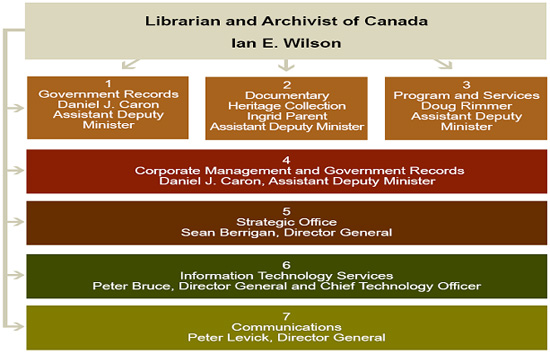
Voted and Statutory Items displayed in the Main Estimates

Departmental Planned Spending Table
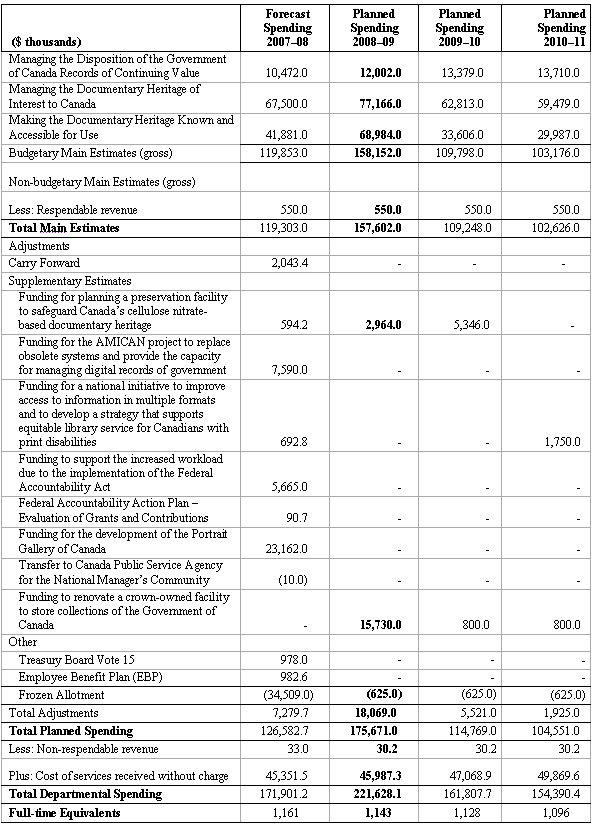
Planned spending decreases over the three year planning period due to sunsetting of capital project initiatives, which includes the construction of an Interim Collection Facility, a Nitrate Preservation Facility, and the Portrait Gallery of Canada. Capital related expenditures accounts for approximately 34 percent of planned spending in 2008-2009 and 5 percent in 2009-2010. Operating related expenditures accounts for approximately 65 percent of planned expenditures in 2008-09, and the following two years are 93 percent and 98 percent, respectively.
Summary Information
Financial Resources ($ thousands)
| 2008-09 | 2009-10 | 2010-11 |
|---|---|---|
| $175,671.0 | $114,769.0 | $104,551.0 |
Human Resources
| 2008-09 | 2009-10 | 2010-11 |
|---|---|---|
| 1,143 | 1,143 | 1,143 |
Strategic Choices (Departmental Priorities)
In 2006, Library and Archives Canada employees worked together to assess the environment in which LAC is working and will be working in the years to come. They examined the opportunities and risks in the organization's environment. That process led to the identification of five Strategic Choices, each of which represents a LAC priority for change above and beyond the ongoing activities described earlier under the Mandate of Library and Archives Canada. Those five Strategic Choices, which have implications for all four LAC program activities, are all ongoing activities. They are:
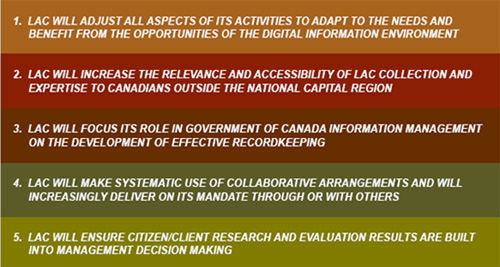
Program Activities by Strategic Outcome
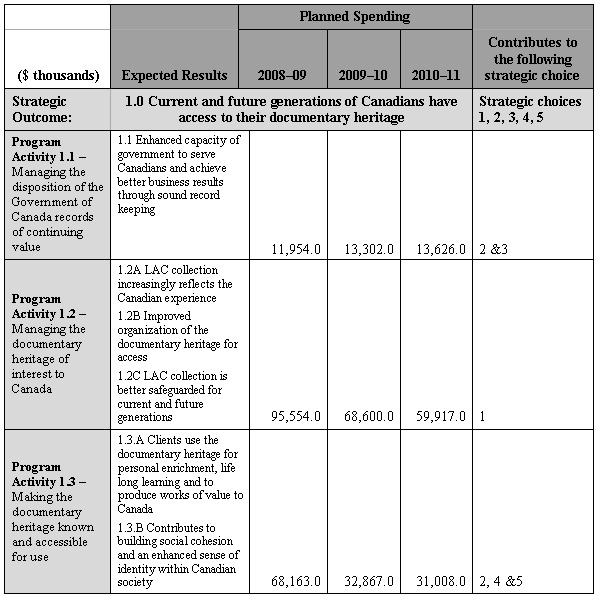
Risks to be Mitigated
Key Risk: Preservation of digital and analog documentary heritage
The risk, for LAC, of not being able to assume all of its responsibilities in terms of the preservation and access to documentary heritage in electronic and analog format, due to lack of the appropriate financial, human and technological resources, or a lack of appropriate partners.
Key Risk: Long-term accommodation and technological infrastructure
The risk, for LAC, of not being able to assume all of its long-term responsibilities in terms of the preservation and access to documentary heritage under its care, due to a lack of appropriate material and technological infrastructure.
Key Risk: Financial Sustainability
The risk, for LAC, of a lack of resources or budget to ensure its core activities or the establishment of the necessary conditions to meet its growing obligations.
Key Risk: Availability and competency of human resources
The risk, for LAC, of not being up to ensuring the transmission of its institutional knowledge to its new generations of employees or not being able to recruit or renew its human capital with staff that have the appropriate knowledge and skills.
Key Risk: Government-wide Initiatives
The risk for LAC is, on one hand, allocating the financial and human resources it must devote to government-wide initiatives and, on the other hand, allocating the resources it must reserve for its activities, in accordance with its mandate and delegated authorities.
Identifying the Five Strategic Choices
The business planning process in 2006 led to the identification of five Strategic Choices, above and beyond LAC's ongoing commitments. Moving ahead on all five choices requires a rebalancing of how LAC has been using its resources and a rethinking of activities. For each strategic choice, we identified intermediate outcomes and a comprehensive set of actions designed to accelerate and focus progress toward those outcomes. Below are the high-level results and implementation strategy. The major actions are described in Section II of this Report.
Strategic Choice 1
LAC will adjust all aspects of its activities to adapt to the needs and benefit from the opportunities of the digital information environment
Expected High-Level Results:
- Digital documentary heritage is acquired and preserved for future generations;
- In their homes, offices or anywhere with hand held devices, Canadians have more timely and convenient access to their documentary heritage;
- LAC makes efficient and effective use of IT in all of its business activities.
Overview of the Implementation Strategy
We will extend our efforts and increase our investments in acquiring and preserving Canada's digital documentary heritage, and in making use of digital technologies-both to improve access and awareness and to rethink our business processes and operations. We will reach this objective through the development of the Canadian Digital Information Strategy (CDIS), a comprehensive digital
asset framework that will support fully automated ingest, preservation and access to digital documentary heritage. We will initiate the Canada Project which will increase our rate of digital acquisition to deal effectively with the annual production of documentary heritage; we will develop functional specifications for digital recordkeeping in government. LAC will also begin working
with partners to build a national network of Trusted Digital Repositories.
LAC will work towards integrated access to our collection by means of a website that is user-friendly, dynamic and interactive. LAC will digitize for use and for preservation and will steadily build the volume of documentary heritage available on our website. LAC will systematically rethink the services we deliver, both to content creators and to content users, and the way in which we do business in order to respond to the demands and maximize opportunities of the digital environment.
This strategic choice will enable us to mitigate the risks associated with the preservation of Canada's digital documentary heritage. It will also be a means of allocating resources in line with achieving financial sustainability and will guide long-term accommodation infrastructure choices.
Strategic Choice 2
LAC will increase the relevance of and accessibility to the LAC collection and the expertise to Canadians outside the National Capital Region (NCR)
Expected High-Level Result
- Canadians outside the NCR have improved access to LAC programs and services relevant to their needs.
Overview of the Implementation Strategy
In order to deliver the documentary heritage of Canada to Canadians beyond the NCR, LAC will focus on activities that demonstrate the relevance and increase the accessibility to our collections. This shift in service horizon will build on a market segmentation of current and potential clientele to identify particular needs and interests. LAC will increase the relevance of and
accessibility to our collections by increasing digital access and content and by working both with organizations who share custody of Canada's documentary heritage and with targeted groups such as genealogists, multicultural communities and teachers. LAC will rely on the expertise of our staff both to improve access and to develop content relevant to Canadians in all regions.
Strategic Choice 3
LAC will focus its role in Government of Canada information management on the development of effective recordkeeping
Expected High-Level Result:
- Government of Canada institutions demonstrate the capacity to create, use and preserve records of long-term value as reliable evidence of business decisions, activities and transactions.
Overview of the Implementation Strategy
The capacity of federal agencies to operate effectively is affected by their challenges in all areas of managing records of business value. LAC will therefore focus our role in government information management on the development of a Recordkeeping Regulatory Regime that will facilitate accountability and stewardship in the creation, use, management and preservation of records as
vital business assets and knowledge resources to support effective decision making, policy development, and the delivery of programs and services to Canadians. We will also assist the government of Canada in ensuring the accessibility of its records of on-going business value.
This strategic choice will enable us to mitigate the risks associated with responding to the government agenda and new projects, as this is likely to be a major continuing focus for government. As well, a clarified emphasis on recordkeeping will help to better define long-term accommodation infrastructure needs, in keeping with the related commitment to financial sustainability.
Strategic Choice 4
LAC will make systematic use of collaborative arrangements and will increasingly deliver on its mandate through or with others
High-Level Result
- The LAC program is more efficiently and effectively delivered through extensive use of partnerships with others.
Overview of the Implementation Strategy
LAC will move from being opportunistic to being more strategic, enduring and sustainable in our partnership practices. We will systematically and comprehensively use collaborative arrangements as a means of delivering on our mandate. LAC can benefit from the synergy and more effective results of working with or through others. The model for this new way of doing business is evident on
the Web. Distributed networks permit a variety of institutions to make contributions based on their strength and capacity. By working together, institutions can realize economies of scale, improve service levels and maximize investments in information and communications technologies and in professional expertise.
In order to achieve this strategic choice, LAC will have to realize a major cultural change. We will shift attitudes from a focus on "doing" to a focus on collaborating or enabling. We will need to develop the necessary capacity and infrastructure to negotiate and manage a wide range of partnerships. LAC will actively seek opportunities to deliver on our mandate by working with or through others.
This strategic choice will enable us to mitigate all our significant risks as it will enable a more appropriate sharing of costs and benefits among partners, with impacts on infrastructure, finances and human resources. It will also provide an approach to addressing the risks related to the preservation of Canada's digital documentary heritage through sharing responsibilities.
Strategic Choice 5
LAC will ensure citizen/client research and evaluation results are built into management decision making
Expected High-Level Results:
- Canadians' need for documentary heritage is understood and acted on in the planning and delivery of the LAC mandate;
- An integrated LAC approach provides federal departments the seamless access to the products and services they require.
Overview of the Implementation Strategy
As LAC moves beyond providing well-established services to a traditional clientele, the institution requires a user research and evaluation capacity. The quantitative and qualitative evidence provided by such research will be a key contributor to effective decision making. User research and evaluation will be critical in enabling LAC to identify Canadians' changing needs and to serve
new markets, as well as to meet our accountability requirements as a federal department.
This strategic choice will enable us to mitigate most significant LAC risks as it will ensure that choices are being made on the basis of clear guidance from target audiences and more comprehensive learning from the evaluation of actions previously taken.
The Canadian Digital Information Strategy and the Canada Project
Individual Canadians and Canadian businesses, governments and non-profit organizations create, use and store massive amounts of electronic records and documentation of many kinds each day. In 2006, the amount of digital information created, captured and replicated was about three million times the information in all the books ever written.
Preserving these digital assets and content is a significant challenge for institutions and organizations throughout the world. Enormous amounts of digital information have already been lost forever. The Canadian Digital Information Strategy, developed by LAC through consultations with a wide range of partners and described later in this RPP, recognized the need to preserve Canada's documentary heritage, whether digital or in any other format, through digital tools.
The Canada Project, a large scale digitization project, which is taking shape now, responds to this need through a broad partnership of academic, public, private and non-profit organizations. Its goal is to digitize and preserve Canada's documentary heritage in a phased approach and make it available online in both of Canada's official languages. It will be organized based on principles of open collaboration, while respecting copyright. It will reflect Canada's linguistic duality and cultural diversity and ensure long-term access for future generations using international digital preservation standards.
The collection of digital information and digitization of information now found in books, other published materials, photographs, documentary art, film, sound recording and other media would be an effort involving multiple partners across Canada. It would be supported by an infrastructure to receive these assets, organize them and make them available to users in Canada and around the world, much of which is described in this RPP through initiatives such as the creation of Trusted Digital Repositories and the implementation of the Virtual Loading Dock. It would open new commercial and research opportunities to Canadians.
In 2008-2009, LAC expects to finalize of the Canadian Digital Information Strategy and to further develop the Canada Project for positioning Canada as a leader in the digital world.

